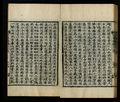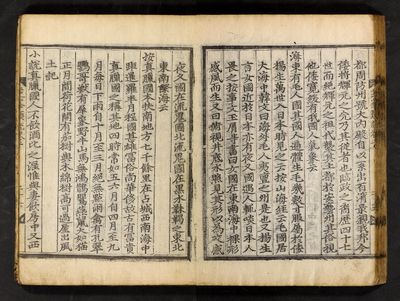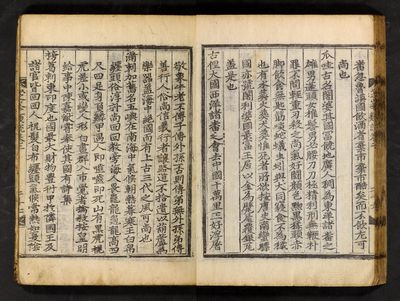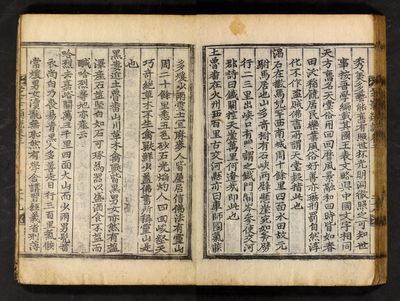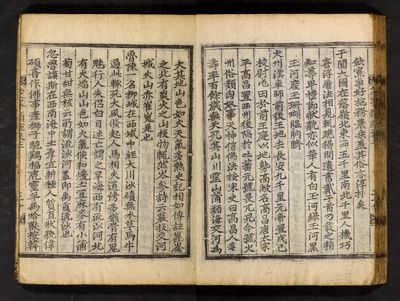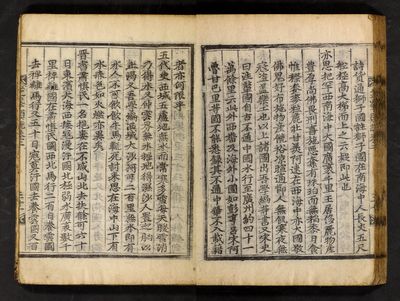"(Translation) 李睟光 外國3"의 두 판 사이의 차이
(→Student 7 : King Kwong Wong) |
|||
| (사용자 2명의 중간 판 2개는 보이지 않습니다) | |||
| 35번째 줄: | 35번째 줄: | ||
{|class="wikitable" style="width:100%; background-color:#ffffff;" | {|class="wikitable" style="width:100%; background-color:#ffffff;" | ||
| − | !style="width:25%;"|Image || style="width: | + | !style="width:25%;"|Image || style="width:75%;"|Text |
|- | |- | ||
| 46번째 줄: | 46번째 줄: | ||
19. 小說。眞臘國人。不飮酒比之淫。惟與妻飮房中。又西 | 19. 小說。眞臘國人。不飮酒比之淫。惟與妻飮房中。又西 | ||
| − | + | ||
| − | |||
|- | |- | ||
| [[File:지봉유설권2외국8.jpg |border|지봉유설권2외국8|400px]] | | [[File:지봉유설권2외국8.jpg |border|지봉유설권2외국8|400px]] | ||
| 60번째 줄: | 59번째 줄: | ||
23. 榜葛剌。東印度也。國最大。財物豐衍。甲於隣國。王及諸官。皆回回人。祝髮白布纏頭。氣候常熱如夏。陰 | 23. 榜葛剌。東印度也。國最大。財物豐衍。甲於隣國。王及諸官。皆回回人。祝髮白布纏頭。氣候常熱如夏。陰 | ||
| − | + | ||
| − | |||
|- | |- | ||
| [[File:지봉유설권2외국9.jpg |border|지봉유설권2외국9|400px]] | | [[File:지봉유설권2외국9.jpg |border|지봉유설권2외국9|400px]] | ||
| 72번째 줄: | 70번째 줄: | ||
26. 撒馬兒罕。漢罽賓也。去嘉峪關萬里。東西相距千里。風景偉麗。土田膏腴。頗類中原。西南番賈多聚於此。俗尚回回敎。有拜天屋。靑石雕鏤極精巧。人物 | 26. 撒馬兒罕。漢罽賓也。去嘉峪關萬里。東西相距千里。風景偉麗。土田膏腴。頗類中原。西南番賈多聚於此。俗尚回回敎。有拜天屋。靑石雕鏤極精巧。人物 | ||
| − | + | ||
| − | |||
|- | |- | ||
| [[File:지봉유설권2외국10.jpg |border|지봉유설권2외국10|400px]] | | [[File:지봉유설권2외국10.jpg |border|지봉유설권2외국10|400px]] | ||
| 88번째 줄: | 85번째 줄: | ||
31. 哈烈。去嘉峪關萬三千里。四面大山而少雨。男髡首。衣尚白。乃喪易靑黑。人多善走。日行三百里。氣候常煖。男女瀆亂無恥。然有學舍。講習經義。省刑薄 | 31. 哈烈。去嘉峪關萬三千里。四面大山而少雨。男髡首。衣尚白。乃喪易靑黑。人多善走。日行三百里。氣候常煖。男女瀆亂無恥。然有學舍。講習經義。省刑薄 | ||
| − | + | ||
| − | |||
|- | |- | ||
| [[File:지봉유설권2외국11.jpg |border|지봉유설권2외국11|400px]] | | [[File:지봉유설권2외국11.jpg |border|지봉유설권2외국11|400px]] | ||
| 102번째 줄: | 98번째 줄: | ||
35. 忽魯謨斯。在西南海中。土厚宜耕種。人質直。狀貌偉碩。喜作佛事。産獅子駞鷄福鹿靈羊馬哈獸。按韓 | 35. 忽魯謨斯。在西南海中。土厚宜耕種。人質直。狀貌偉碩。喜作佛事。産獅子駞鷄福鹿靈羊馬哈獸。按韓 | ||
| − | + | ||
| − | |||
|- | |- | ||
| [[File:지봉유설권2외국12.jpg |border|지봉유설권2외국12|400px]] | | [[File:지봉유설권2외국12.jpg |border|지봉유설권2외국12|400px]] | ||
| 109번째 줄: | 104번째 줄: | ||
詩貨通獅子國註。獅子國在南海中。人長丈五尺。船極高大。梯而上之云。疑卽此也。 | 詩貨通獅子國註。獅子國在南海中。人長丈五尺。船極高大。梯而上之云。疑卽此也。 | ||
| − | + | ||
| − | |||
|- | |- | ||
|} | |} | ||
| − | + | <!-- | |
=='''Discussion Questions'''== | =='''Discussion Questions'''== | ||
# | # | ||
| 120번째 줄: | 114번째 줄: | ||
=='''Further Readings'''== | =='''Further Readings'''== | ||
| − | + | ||
<div style="color:#008080;"> | <div style="color:#008080;"> | ||
* View together with '''~~'''. | * View together with '''~~'''. | ||
</div> | </div> | ||
| − | + | ||
* | * | ||
* | * | ||
| 315번째 줄: | 309번째 줄: | ||
21. 古俚大國。西洋諸番之會。去中國十萬里。王好浮屠。敬象牛。老不傳子。傳外孫。否則傳弟。無外孫弟。傳善行人。俗尚信義。行者讓路。道不拾遺。以葫蘆爲樂器。蓋海中絶國。而有上古三代之風。可尚也。 | 21. 古俚大國。西洋諸番之會。去中國十萬里。王好浮屠。敬象牛。老不傳子。傳外孫。否則傳弟。無外孫弟。傳善行人。俗尚信義。行者讓路。道不拾遺。以葫蘆爲樂器。蓋海中絶國。而有上古三代之風。可尚也。 | ||
<br /> | <br /> | ||
| − | + | As to the great state of Koi [RR: Goi] (now Kozhikode/Calicut), it is a confederation of various states in the western ocean. It is apart from China ten thousand ri. Its king is fond of Buddhism and reveres elephants and cows. When he grew old, he did not pass the throne to his son, instead he tried to pass it to his maternal grandson or his younger brother. But he does not have a grandson nor a brother. So he passed the throne to a man of good deeds. Their social custom regards highly of honor and morality. Pedestrians give way to each other. No one keeps anything found on the road. They use bottle gourd as musical instrument. Therefore it is a peerless state in the sea. And it has the atmosphere of the ancient three dynasties, thus it can be respected. | |
22. 滿剌加。舊名五嶼。在南海中。氣候朝熱暮寒。王白帛纏頭。俗淳朴。尚回回敎。旁海人畏龜龍。龜龍高四尺四足。身負鱗甲。遇人卽嚙。嚙卽死。山有黑虎。視虎差小。或變人形。白晝群入市。覺者擒殺。按皇明給事中陳嘉猷。嘗奉使其國。有詩集。 | 22. 滿剌加。舊名五嶼。在南海中。氣候朝熱暮寒。王白帛纏頭。俗淳朴。尚回回敎。旁海人畏龜龍。龜龍高四尺四足。身負鱗甲。遇人卽嚙。嚙卽死。山有黑虎。視虎差小。或變人形。白晝群入市。覺者擒殺。按皇明給事中陳嘉猷。嘗奉使其國。有詩集。 | ||
<br /> | <br /> | ||
| − | As to Malacca, its old name is Five Islands. It is situated in the middle of the | + | As to Malacca, its old name is Five Islands. It is situated in the middle of the southern sea. The climate during the day is hot and during the night is cold. Its king wraps his head with white silk. The social custom is pure and simple. They revere the religion of Islam. People live by the sea fear turtle dragons. The turtle dragons are four ch'ŏk [RR: cheok] high and have four legs. They bear scaled shell and bite whenever they encounter people. Those who are bitten die promptly. In its mountains live black tigers. Comparing to tigers, they are smaller. Sometimes they transform into human-likeness and flock into the market in broad daylight. Those who aware of them are captured and killed. This is written according to the August Ming Supervising Secretary Chen Jiayou, who was once sent as an envoy to this state and had left a collection of poetry. |
23. 榜葛剌。東印度也。國最大。財物豐衍。甲於隣國。王及諸官。皆回回人。祝髮白布纏頭。氣候常熱如夏。陰陽醫卜百工技藝。大類中國。曆有十二月無閏。風俗朴厚。好耕殖。一年二熟。婦女不施脂粉。自然嬌白。飮食。男女不同處。夫死不再嫁。妻死不再娶。若孤寡無倚。一村輪養之。有兜羅錦。闊四五尺。厚可五分。背面皆毳絨。 | 23. 榜葛剌。東印度也。國最大。財物豐衍。甲於隣國。王及諸官。皆回回人。祝髮白布纏頭。氣候常熱如夏。陰陽醫卜百工技藝。大類中國。曆有十二月無閏。風俗朴厚。好耕殖。一年二熟。婦女不施脂粉。自然嬌白。飮食。男女不同處。夫死不再嫁。妻死不再娶。若孤寡無倚。一村輪養之。有兜羅錦。闊四五尺。厚可五分。背面皆毳絨。 | ||
<br /> | <br /> | ||
| − | Bengala (now Bangladesh) is East India. Its state is the greatest. Its wealth and products are overflowingly abundant | + | As to Bengala (now Bangladesh), it is East India. Its state is the greatest. Its wealth and products are overflowingly abundant that ranked first among neighbors. Its king and officials are all Muslims, and shave their head and wrap them in white cloth. The climate is constantly hot, like summer. Yin and Yang, medicine and divination, all sort of crafts, and artistry are very similar to those of China. Its calendar has twelve months and does not have intercalary months. Its social custom is simple and loyal. Its people are fond of cultivation and breeding. It has two crops a year. Its women do not apply rouge and powder and naturally have charmingly white complexion. As to drinking and eating, men and women have them in different places. Whenever their husbands die, they do not remarry. Whenever their wives die, they do not take another. If they are alone and have no dependants, the whole village takes turns to support them. It has Tūla cotton<ref>This refers to a kind of blanket that is made by Tūla cotton cultivated in India.</ref>, which is four to five ch'ŏk [RR: cheok] wide and can be as thick as five pun [RR: bun]. IChagatai Khanatets back is all fine fur. |
25. 溜山在西海中。四面皆海。無城郭。依山聚居。皆以溜名。無慮三千。舟行遇風失入溜卽溺。土人曰此弱水三千也。人巢居穴處。啖魚蝦無衣。草木葉蔽前後。按韻府曰。弱水在西海中。不能負羽。蓋是也。又晉書。扶餘國在玄菟北。北有弱水。肅愼氏東濱大海。北極弱水。續仙傳曰。蓬萊隔弱水三萬里。非飛仙莫至。然則東北亦有弱水矣。 | 25. 溜山在西海中。四面皆海。無城郭。依山聚居。皆以溜名。無慮三千。舟行遇風失入溜卽溺。土人曰此弱水三千也。人巢居穴處。啖魚蝦無衣。草木葉蔽前後。按韻府曰。弱水在西海中。不能負羽。蓋是也。又晉書。扶餘國在玄菟北。北有弱水。肅愼氏東濱大海。北極弱水。續仙傳曰。蓬萊隔弱水三萬里。非飛仙莫至。然則東北亦有弱水矣。 | ||
| 333번째 줄: | 327번째 줄: | ||
28. 渴石。在撒馬兒罕西南。城周十餘里。四面水田。故元駙馬居也。山多奇樹。有石峽。兩壁懸崖。宛如斧劈。行二三里。出峽口有門。謂之鐵門關。岑參使交河郡詩曰。鐵關控天崖。萬里何遼哉。卽此也。 | 28. 渴石。在撒馬兒罕西南。城周十餘里。四面水田。故元駙馬居也。山多奇樹。有石峽。兩壁懸崖。宛如斧劈。行二三里。出峽口有門。謂之鐵門關。岑參使交河郡詩曰。鐵關控天崖。萬里何遼哉。卽此也。 | ||
<br /> | <br /> | ||
| − | Kalsŏk [RR: Galseok] | + | Kalsŏk [RR: Galseok]<ref>nowadays Shakhrisabz in Uzbekistan</ref> is located to the Southwest of Samarkand. The circumference of the city is more than ten ri. Its four sides are surrounded by paddy fields. It was the residence of an imperial son-in-law of the Yuan in the past<ref>This refers to Tamerlane, who married a daugther of the khan of Eastern Chagatai Khanate.</ref>. In its mountains are many strange trees. There is a rocky gorge. As to the cliffs of its two sides, it resembles a cleavage from an axe. Walk two to three ri, after exiting the gorge, is a gate, which is called the Iron Gate Pass. In the poem "Envoy to Jiaohe County<ref>This refers to Gaochang.</ref>" Cen Shen says, "The Iron Pass controls the end of the world, how far is ten thousand li?" This namely is the Iron Gate Pass. |
*Discussion Questions: | *Discussion Questions: | ||
| 427번째 줄: | 421번째 줄: | ||
37. 五代史。西域五盧地無水。而常寒多雪。每天暖雪消。乃得水。又仲雲界無水。掘地得濕沙。人置之胸以止渴。又吾學編。西域大沙河可二百里無水。卽有水。人不可飮。飮牛馬輒死。討來思在海中。山下有水。赤色如火燃。亦異矣。 | 37. 五代史。西域五盧地無水。而常寒多雪。每天暖雪消。乃得水。又仲雲界無水。掘地得濕沙。人置之胸以止渴。又吾學編。西域大沙河可二百里無水。卽有水。人不可飮。飮牛馬輒死。討來思在海中。山下有水。赤色如火燃。亦異矣。 | ||
| − | In the | + | In the ''History of Five Dynasties'' (五代史), five lands of Lu 盧<ref>also written as 吾盧, Yīwú 伊吾 or Yīwúlú 伊吾卢</ref> in the Western region “have no water, are always cold and have lots of snow. Every time the weather gets warm, the snow disappears and water is obtained from this."<ref>新五代史, Book 74. "Appendix on Four Barbarians" (四夷附录), 3: 34 |
| − | + | https://ctext.org/wiki.pl?if=en&res=626823&searchu=%E5%A4%9A%E9%9B%AA&remap=gb</ref> The Zhongyun 仲雲<ref>See | |
| + | https://en.wikipedia.org/wiki/Hami | ||
| + | https://zh.m.wikipedia.org/wiki/仲云国</ref> region has no water, either. One can get moist sand by digging the ground, which he can place on the chest to quench thirst. Also in Zheng Xiao's (鄭曉, 1499-1566) “Wuxuebian“ 吾學編 (ca. 1522), the great sand river of the West can be 200-''li'' without water. Even if there is water, people cannot drink it. Feeding it to horses and cattle will always kill them. Taolaisi 討來思 is located in the middle of the sea. There is water beneath the mountain that is red in color like burning fire. This is also unusual. | ||
38. 晉書。肅愼氏。一名挹婁。在不咸山北。去扶餘可六十日。東濱大海。西接寇漫汗國。北極弱水。廣袤數千里。裨離國。在肅愼氏國西北。馬行二百日。養雲國。去裨離馬行又五十日。寇莫汗國。去養雲國又百"日。一群國。去莫汗又百五十日。計去肅愼五萬餘里。晉武時各遣小部。獻其方物。按黑水靺鞨。卽肅愼氏也。黑水。今黑龍江也。 | 38. 晉書。肅愼氏。一名挹婁。在不咸山北。去扶餘可六十日。東濱大海。西接寇漫汗國。北極弱水。廣袤數千里。裨離國。在肅愼氏國西北。馬行二百日。養雲國。去裨離馬行又五十日。寇莫汗國。去養雲國又百"日。一群國。去莫汗又百五十日。計去肅愼五萬餘里。晉武時各遣小部。獻其方物。按黑水靺鞨。卽肅愼氏也。黑水。今黑龍江也。 | ||
| − | In the | + | In the ''Book of Jin'' (晉書), the Sushen 肅愼 tribe, Yilou 挹婁 by another name, resides at the north of Buxian 不咸 Mountain. Going there from Buyeo 扶餘 can take sixty days. To the East, it is adjacent to the great sea. To the West, it shares borders with Koumanhan 寇漫汗 state. To extreme north is Ruoshui 弱水. The area is thousands of [square] ''li''. The state of Bei’er 裨離 is located to the northwest of the state of Sushen. By horse it takes 200 days. The state of Yangyun 養雲 is another 50-day distance by horse from Bei'er. The state of Kou-Mohan is another 100-day distance from the state of Yangyun 養雲. The state of Yiqun 一群 is another 50-day distance from Mohan. Estimated distance from Shushen is over 50,000 ''li''. During the reign of Jin Wudi (266-290), they each dispatched Xiaobu 小部 to pay tributes of local products. Adjacent to Mohe 靺鞨 of Hesui 黑水 (Black Water) is the Sushen 肅愼 tribe. Hesui is today’s Helungjiang (Black Dragon River). |
| − | The state of Bei’er is located to the northwest of the state of Sushen. | ||
39. 五代史曰。契丹東距海有鐵甸。其地少草木。水鹹濁如血。北有牛蹄突厥。人身牛足。又北狗國。人身狗首。長毛不衣。語爲犬嗥。生男爲狗女爲人。東北至襪劫子。其人善射。遇人輒殺而生食。契丹嘗遣十人。齎乾麨北行一年。經四十三城。居人多以木皮爲屋。其語言無譯者。不知國土名號。其地遇平地則溫和。山林則寒冽。至三十三城。得一人能鐵甸語云。自此以往。龍蛇猛獸魑魅群行。不可往。此北荒之極也。余謂此北荒外。安知又有世界。如三才圖會所紀者乎。 | 39. 五代史曰。契丹東距海有鐵甸。其地少草木。水鹹濁如血。北有牛蹄突厥。人身牛足。又北狗國。人身狗首。長毛不衣。語爲犬嗥。生男爲狗女爲人。東北至襪劫子。其人善射。遇人輒殺而生食。契丹嘗遣十人。齎乾麨北行一年。經四十三城。居人多以木皮爲屋。其語言無譯者。不知國土名號。其地遇平地則溫和。山林則寒冽。至三十三城。得一人能鐵甸語云。自此以往。龍蛇猛獸魑魅群行。不可往。此北荒之極也。余謂此北荒外。安知又有世界。如三才圖會所紀者乎。 | ||
| − | It says in the History of the Five Dynasties, “In the sea to the east of Khitan is Tiedian. Its | + | It says in the ''History of the Five Dynasties'', |
| − | + | “In the sea to the east of Khitan 契丹 is Tiedian 鐵甸. ... Its land has little plants. The water is salty and dirty as blood.”<ref>新五代史, Book 73. "Appendix on Four Barbarians" (四夷附录), 2: 14 | |
| + | https://ctext.org/wiki.pl?if=en&chapter=158998&remap=gb#p15</ref> | ||
| + | “To the north there are Niuti Tujue 牛蹄突厥 (Ox-hoof Turks), with human bodies and ox-hooves.” <ref>新五代史, Book 73. "Appendix on Four Barbarians" (四夷附录), 2: 15 | ||
| + | https://ctext.org/wiki.pl?if=en&chapter=158998&remap=gb#p16</ref> | ||
| + | ”And in the Gouguo 狗國 (Dog-land) in the north, [people] have human bodies and dogs’ heads, are long haired and unclothed. Their language is a canine haul. At birth, the men become dogs and women become humans.” <ref>Ibid.</ref> | ||
| + | ”To the northeast, one reaches Wajieji 襪劫子—its people are good archers. If they meet a person, they immediately kill him and eat him raw.”<ref>Ibid.</ref> | ||
| + | ”Khitan had dispatched ten people. Carrying dry barley powder, they traveled north for one year, past forty-three cities. Many residents used barks of trees for housing. As there was no interpretor of their language, the names of the country were unknown. Their land bordering the plane was temperate and [the land bordering] the forest was cold and chilly. When they reached thirty-third city, they got one man who could speak Tiedian language. ‘From this point on, even a group of dragons, serpents, birds of prey, and chimei 魑魅 will not be able to go [any further].' Its north is an extremity of wasteland.” I call this beihuwang wai (the land beyond the northern wasteland). How could one know there is another world there? Such is what is recorded in ''Sancai tuhui'' 三才圖會. | ||
40. 稗史言回回國。事天事祖之外。無所崇。有詩曰僧言佛子在西空。道說蓬萊在海東。惟有孔門眞實事。眼前無日不春風。余謂回回在西域。而其言如此。以中華之士。而乃尚佛敎何也。回回文字。有篆草楷三樣。其曆法與中國僅差二刻。聞西南諸國。奉回回敎法者多云。蓋斥佛法而以事天爲重耳。又其俗善保養。常護外腎。使不着寒。夜臥以手握之"令暖。謂此乃生人性命之本根。不可不保護。此說亦有理。回回或以爲古之大食國。非唐之回鶻,回紇也。余赴京時。見其國人。皆白布纏頭。亦詭矣。 | 40. 稗史言回回國。事天事祖之外。無所崇。有詩曰僧言佛子在西空。道說蓬萊在海東。惟有孔門眞實事。眼前無日不春風。余謂回回在西域。而其言如此。以中華之士。而乃尚佛敎何也。回回文字。有篆草楷三樣。其曆法與中國僅差二刻。聞西南諸國。奉回回敎法者多云。蓋斥佛法而以事天爲重耳。又其俗善保養。常護外腎。使不着寒。夜臥以手握之"令暖。謂此乃生人性命之本根。不可不保護。此說亦有理。回回或以爲古之大食國。非唐之回鶻,回紇也。余赴京時。見其國人。皆白布纏頭。亦詭矣。 | ||
| 548번째 줄: | 549번째 줄: | ||
[[Category:2018 Hanmun Summer Workshop]] | [[Category:2018 Hanmun Summer Workshop]] | ||
[[Category:Advanced Translation Group]] | [[Category:Advanced Translation Group]] | ||
| + | --> | ||
2022년 2월 15일 (화) 00:58 기준 최신판
| Primary Source | ||
|---|---|---|
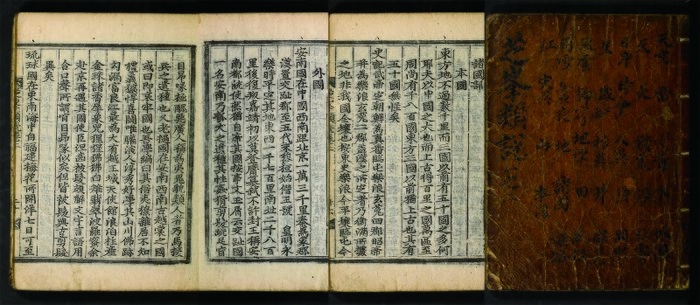 |
Title | |
| English | ||
| Chinese | 芝峯類說 | |
| Korean(RR) | 지봉유설(Jibongyuseol) | |
| Text Details | ||
| Genre | Literati Writings | |
| Type | ||
| Author(s) | 李睟光 | |
| Year | ||
| Source | ||
| Key Concepts | ||
| Translation Info | ||
| Translator(s) | Participants of 2018 Summer Hanmun Workshop (Advanced Translation Group) | |
| Editor(s) | ||
| Year | 2018 | |
Introduction
In this section of on Foreign Countries(外國), Isugwang lists countries ranging from those around Japan all the way up to the Islamic world around the central Asia.
One interesting point is that here he mixed empirical record and thing that seems fantastical to us. However, based on his assertion in his own preface, he might well have taken all of these description to be faithful to the reality in some sense. In his preface, he says "as to the things mythical and strange, I did not record a single item(若事涉神怪者, 一切不錄)."[1] Thus, things such as the Country of Beasts and black tigers that transforms into human shapes might have been real enough to be recorded in his book.
As for the apparently fantastic countries, he seems to have been affected by both the Classic of Mountains and Seas(山海經, Shanhaijing) and Matteo Ricci's Complete Geographical Map of Ten Thousand Countries(Kunyu wanguo quantu 坤輿萬國全圖)." Ricci himself incorporated the fantastic animals and countries in his new world map. For example, the Country of Beasts Isugwang describes is located on the northeast of Japan near the North Pole in Ricci's map. This location roughly matches Isugwang's description. According to a research on 坤輿萬國全圖, Ricci was also using the Classic of Mountains and Seas to supplement the information he heard from the European explorers.[2]
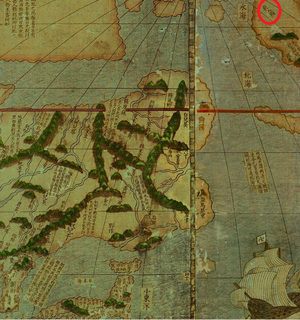
Original Script
- ↑ "자서(自序)." http://www.krpia.co.kr/viewer?plctId=PLCT00004513&tabNodeId=NODE04082994#none
- ↑ Zhang, Qiong. 2015. Making the New World Their Own: Chinese Encounter with Jesuit Science in the Age of Discovery. Leiden: Brill. pp.73-35.
- ↑ https://artsandculture.google.com/asset/%EC%8B%A0%EA%B3%A4%EC%97%AC%EB%A7%8C%EA%B5%AD%EC%A0%84%EB%8F%84-%E6%96%B0%E5%9D%A4%E8%88%87%E8%90%AC%E5%9C%8B%E5%85%A8%E5%9C%96/twGEi2Om9Nmouw?ms=%7B%22x%22%3A0.49989971418491963%2C%22y%22%3A0.18538077425881158%2C%22z%22%3A12.006697790604882%2C%22size%22%3A%7B%22width%22%3A0.2273922011013367%2C%22height%22%3A0.3003427245780979%7D%7D
